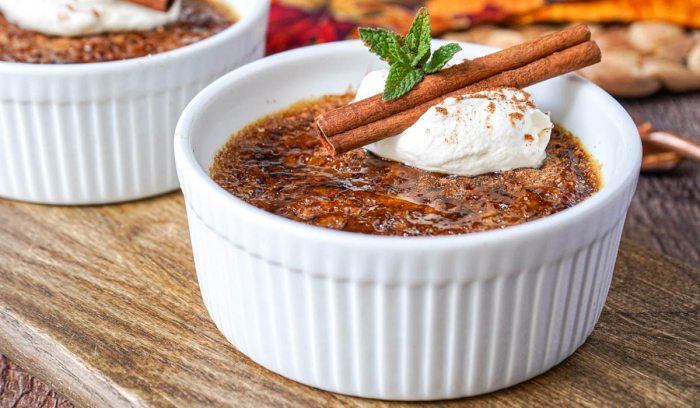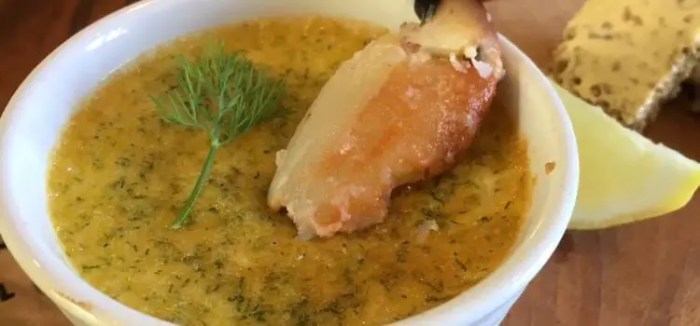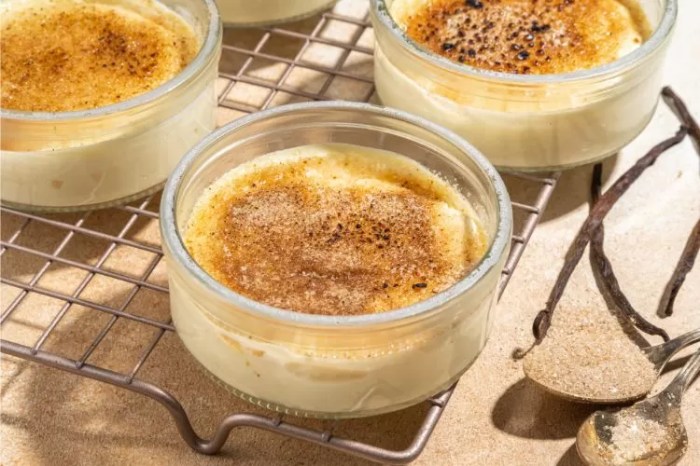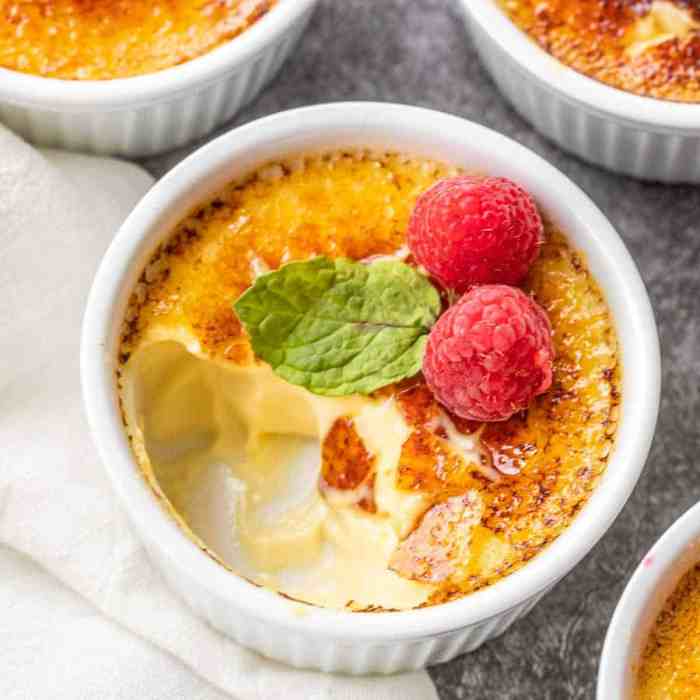
Prepare to embark on a culinary adventure with our tantalizing crab brulee recipe. This delectable dish combines the richness of crab with the sweet, caramelized crust of a creme brulee, creating a symphony of flavors that will dance on your palate.
From the art of searing to the precision of flambeing, we’ll delve into the techniques that elevate this dish beyond the ordinary. And with variations that cater to diverse tastes and dietary needs, you’ll discover the versatility of this culinary gem.
Ingredients and Preparation: Crab Brulee Recipe
The crab brulee recipe combines the delicate flavors of crab and custard, creating a delightful and elegant dish. To prepare this culinary masterpiece, you will need the following ingredients:
- Fresh crab meat, picked and flaked
- Heavy cream
- Eggs
- Dijon mustard
- Grated Parmesan cheese
- Salt and pepper to taste
- Unsalted butter
- Fresh parsley, for garnish
Once you have gathered your ingredients, follow these steps to prepare the crab brulee:
Cleaning the Crab
If using fresh crab, start by cleaning it. Remove the top shell and gills, then crack the claws and legs to extract the meat. Use a fork to gently flake the crab meat, discarding any shells or cartilage.
Making the Custard
In a large bowl, whisk together the heavy cream, eggs, Dijon mustard, Parmesan cheese, salt, and pepper. Stir in the flaked crab meat and set aside.
Assembling the Brulee
Preheat your oven to 325°F (165°C). Grease six ramekins with unsalted butter and divide the crab custard mixture evenly among them. Place the ramekins in a baking dish and fill the dish with hot water to create a water bath.
Baking the Brulee
Bake the crab brulee for 30-35 minutes, or until the custards are set and the tops are lightly browned. Remove the ramekins from the water bath and let them cool for a few minutes before serving.
Serving
Garnish the crab brulee with fresh parsley and serve immediately. Enjoy the rich and creamy texture of the custard, complemented by the delicate sweetness of the crab.
Culinary Techniques and Flavors

The crab brulee showcases a symphony of culinary techniques, each contributing to the dish’s exquisite flavor and presentation.
Searing the crab meat in a hot skillet caramelizes its surface, creating a golden-brown crust that locks in its natural juices. Baking the crab mixture in a water bath ensures even cooking and a velvety-smooth texture. The final touch, flambeing the dish with brandy, not only adds a dramatic flair but also enhances its flavor by evaporating the alcohol and concentrating its essence.
Flavor Profile
The flavor profile of crab brulee is a harmonious balance between sweet and savory elements. The natural sweetness of the crab meat is complemented by the subtle sweetness of the custard and the caramelized crust. The addition of herbs and spices, such as tarragon and cayenne pepper, adds depth and complexity to the dish.
The result is a sophisticated and indulgent culinary experience.
Presentation and Garnish

The presentation of crab brulee plays a crucial role in enhancing its appeal and showcasing its delicate flavors. Traditionally, crab brulee is served in individual ramekins, creating a visually stunning array on the plate.
To elevate the presentation, consider using different colored ramekins or garnishing the brulee with vibrant microgreens, edible flowers, or citrus zest. These elements add a touch of color and freshness, making the dish more visually captivating.
Garnishes, Crab brulee recipe
- Fresh Herbs:Delicate herbs like chives, tarragon, or parsley add a touch of greenery and enhance the crab’s natural flavors.
- Citrus Zest:The bright acidity of lemon or lime zest complements the richness of the crab and adds a vibrant pop of color.
- Microgreens:A sprinkling of microgreens, such as pea shoots or arugula, provides a fresh and peppery contrast to the creamy brulee.
- Edible Flowers:Pansies, nasturtiums, or chive blossoms add a delicate touch of color and elegance to the dish.
- Truffle Shavings:For a luxurious touch, shaved black or white truffles enhance the earthy flavors of the crab.
Variations and Substitutions

The classic crab brulee recipe offers a delicious combination of flavors and textures. However, you can easily customize it to suit your preferences or dietary needs.
Experiment with different types of seafood, such as shrimp, lobster, or scallops. You can also adjust the sweetness level by adding more or less sugar to the custard base.
Substitutions
- For a dairy-free option, you can substitute coconut milk or almond milk for the heavy cream.
- If you don’t have fresh crab, you can use canned crab meat. Just be sure to drain it well before using.
- If you’re watching your calories, you can reduce the amount of butter in the recipe. You can also use a low-fat or fat-free cheese.
History and Cultural Significance

Crab brulee is a modern dish with a rich culinary heritage. Its origins can be traced back to the classic French dessert, creme brulee. In the early 19th century, French chefs began experimenting with savory ingredients in desserts, and crab brulee was born.
Craving a gourmet seafood dish? Try the crab brulee recipe for a luxurious treat. The velvety crab custard is topped with a crispy crust, creating a tantalizing combination of textures. For a vegetarian delight, consider the chicken of the woods recipe . This flavorful mushroom dish boasts a meaty texture and can be prepared in a variety of ways, from sautéing to grilling.
The dish quickly gained popularity in France and spread throughout Europe. It was introduced to the United States in the early 20th century and has since become a staple of American fine dining.
Cultural Significance
Crab brulee is a symbol of culinary innovation and the fusion of different cultures. It represents the creativity and artistry of chefs who are constantly pushing the boundaries of cuisine.
If you’re a fan of seafood, check out this crab brulee recipe that combines the rich flavors of crab and the creamy texture of a custard. And for those who love to forage, try this chicken of the woods recipe that transforms the edible mushroom into a delicious and earthy dish.
The dish is also a testament to the cultural significance of crab in many parts of the world. Crab is a delicacy in many Asian countries and is often used in celebratory dishes. In the United States, crab is a popular seafood choice and is often associated with special occasions.
Summary

Whether you’re a seasoned chef or a culinary novice, our crab brulee recipe is an invitation to explore the boundless possibilities of cooking. With its rich history and cultural significance, this dish transcends mere sustenance and becomes a testament to the power of culinary creativity.
So gather your ingredients, prepare your palate, and let’s embark on a culinary journey that will leave you craving more.
FAQ Compilation
Can I substitute other seafood for crab in this recipe?
Absolutely! Feel free to experiment with shrimp, lobster, or even scallops to create your own unique variations.
What is the ideal temperature for searing the crab?
Aim for a medium-high heat, around 375-400°F (190-204°C), to achieve a golden-brown crust without overcooking the crab.
How can I achieve the perfect caramelized crust?
Use a kitchen torch to caramelize the sugar topping. Hold the torch about 2-3 inches away from the surface and move it in circular motions until the sugar melts and bubbles.





